There have been many who have laid claim to the invention of the folding bike. Humorously, a bike manufacturer (who shall remain nameless not to embarrass them) audaciously claims on their website to have produced the world’s first folding bike in 1973 – wishful thinking by their marketing department.
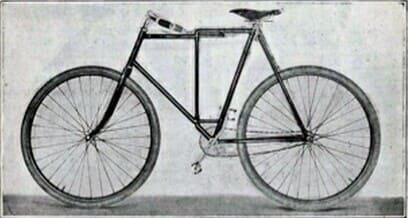
The folding bike has been around for considerably longer than one might imagine, and most claims of being the first are erroneous.
When Was The Bicycle First Invented?
First things first, though, you can only have a folding bike with the bicycle’s invention. A concise history lesson on the bicycle is in order. Here again, we have some disputed claims about the story, and historians will probably never be able to identify the exact moment of creation.
For a while, some had claimed that Leonardo Da Vinci invented the bicycle based on a sketch found in his Codex Atlanticus.
However, this sketch was later determined to be a forgery.
Though many historical accounts were written before this forgery was discovered still credit Da Vinci as the bicycle inventor. There were a few “pre-bicycles” invented before the appearance of what one would recognize as a bicycle.
The first bicycle was probably the “Celerifere,” developed by a French count named Mede de Sivrac in 1790. It consisted of two wheels connected by a beam and was decorated to look like a horse or a lion.
There was no steering mechanism or pedals, and it was a whimsical novelty meant to entertain the idle rich. In 1818, Baron Karl von Drais of Germany showed his “Draisienne” to the world in Paris.
The Draisienne (below) had steering but still no pedals.

In 1860, Frenchman Ernest Michaux and his brother Pierre added a crank and pedals to the front wheel of their “Velocipede” (below), and we have what starts to look like a bicycle that we all would recognize.
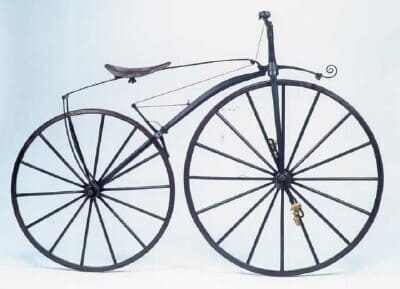
In the years that followed, the English were instrumental in moving bicycle technology forward, culminating in the so-called “safety bike” (below right) in 1885, which resembles today’s bicycles in form and function.
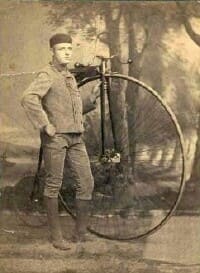
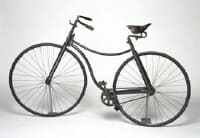
The safety bike was so named because it was safer and easier to use than the large wheeled bikes that proceeded it, most notably the penny-farthing (below left). These giant wheeled bicycles were also called “ordinary bicycles.”
Folding Bike History
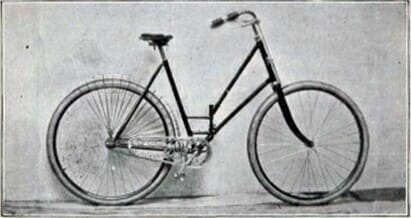
This brings us to the folding bike, where history gets a bit murky for several reasons. First, there is the issue of what exactly constitutes a “folding” bicycle. There are a few historical references to so-called folding bicycles.
Still, their descriptions sound more like “separable” or “break-away” bikes rather than actual folders wherein the frame collapses in some manner while still staying attached to itself.
Secondly, there are competing claims from many inventors in different countries vying to be called the original inventor of the folding bike. Most of these claims can’t be documented convincingly, but that’s not to say that they aren’t necessarily true.
The actual first inventor of the folding bike may never be known with absolute certainty, but there are a few contenders.
Interestingly, the folding tricycle preceded the folding bicycle since there are a few references to them dating from the 1880s from such companies as Bayliss Thomas in England and The Pope Manufacturing Company in the U.S.
Englishman William Grout is often credited for inventing the first folding bike in 1878.
Still, from most accounts, his bicycle (a penny-farthing design pictured below) had a folding front wheel and a disassembled frame.
It has been more correctly referred to as a “portable” bicycle than an actual folding bicycle.

Who Invented Folding Bikes?
One of the first, if not the first, credibly documented inventions of a folding bike is by an American inventor, Emmit G. Latta. He filed a patent in the U.S. on September 16, 1887, and it was issued on February 21, 1888.
An excerpt from the patent reads:
“The object of this invention is to provide a machine that is safe, strong, and serviceable, and more easily steered than the machines now in use, and also to construct the machine in such a manner that the same can be folded when not required for use, to require little storage-room and facilitate its transportation.”
Emmit G. Latta
Latta sold this patent to the Pope Manufacturing Company, who bought dozens of bicycle-related patents during the dawn of the bicycle age in America, including the first U.S. pedal-bicycle patent issued to Pierre Lallement in 1866.
Pope sold bikes under the Columbia brand name.
It is unknown if the Latta bike was ever marketed by Pope since no existing examples have yet been found. Latta also invented a couple of folding tricycles around the same time as his folding bike and sold those patents to Pope. Drawings from the Latta folding bike patent are shown below.
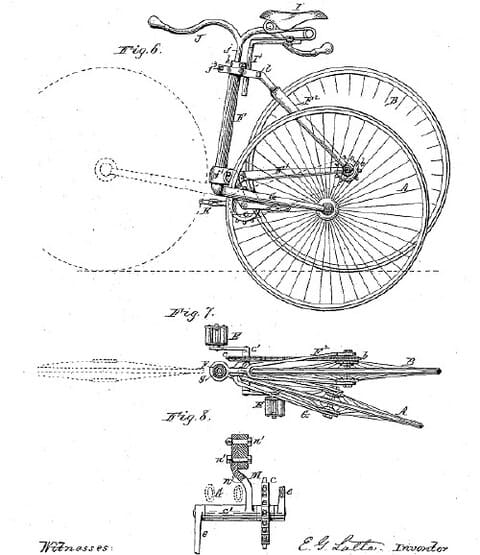
Another early documented invention of a folding bike is by an American, Michael B. Ryan, in his U.S. patent filing dated December 26, 1893, and issued on April 17, 1894. An excerpt from the patent reads:
“The principle object of my present invention is to produce a bicycle so constructed that it can be easily folded and thus take up less space in length when not in use or transported or stored.”
Michael B. Ryan
Drawings from the actual patent are below. The significance of this bike will be explained a bit later.
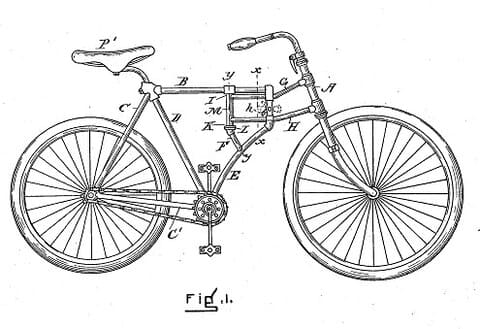
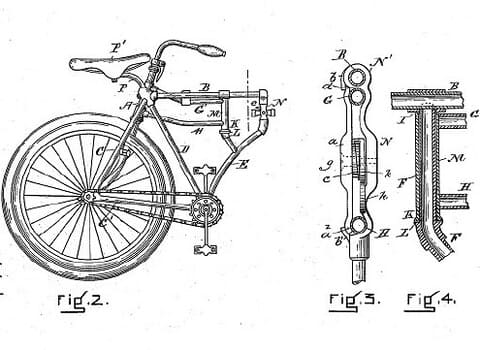
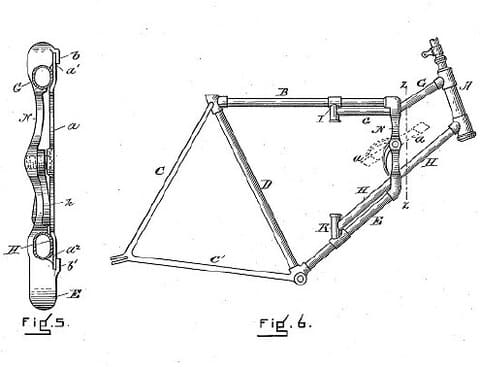
The first folding tandem bicycle was probably invented by Julien Simon and Victor Dussault, both from Paris, France. In their patent application dated May 10, 1895, they described a regular folding bike that could be converted into a folding tandem by adding another frame and connecting parts.
Drawings from the patent are shown below.
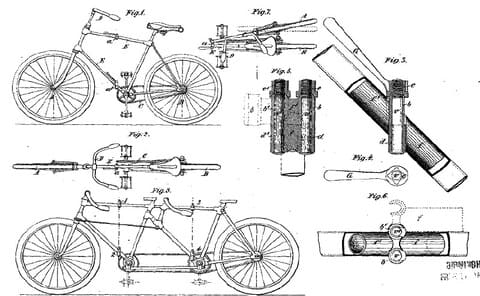
Several historical texts claim that the French military invented the first folding bike. In particular, a French military officer named Captain Gérard is given credit. This was not true, but there is a fascinating story behind this misnomer.
A complete telling of the story is in a book entitled “Charles Morel – constructeur dauphinois sous la troisième république.”
Since it is in French, here’s the short version.
Charles Morel, a wealthy French industrialist, became enamored with the relatively new bicycle craze, devised a folding bicycle, and built a prototype in 1892.
Independently, in 1893, a French army lieutenant named Henry Gérard imagined the use of a folding bike by the army and filed a patent for one through his father-in-law Henri Noêl on June 27, 1893.
The problem was that this bike was deeply flawed and didn’t work.
While looking for help to fix the design flaws, he was introduced to Charles Morel. Mr. Morel showed his prototype bike to Gérard and suggested that he meet with one of his mechanics named Dulac to get his help perfecting a functional folding bike design.
Dulac was successful in this endeavor, so on October 5, 1894, Charles Morel and Lieutenant Gérard entered an agreement to manufacture and commercialize a folding bike. Morel would finance and oversee the manufacturing, and Gérard would promote it.
Production of the cycle began in April 1895, and it was an immediate success, with orders quickly exceeding production capacity.
In October 1895, a retail store was opened in Paris to sell the bike to the public. Gérard was tasked to market to the French military, which was subsequently supplied with 25 test bikes.
The Romanian and Russian armies placed orders as well.
Lieutenant Gérard was successful in selling the idea of using folding bikes to the military and was ultimately put in charge of a regiment of folding bike-equipped soldiers and was eventually promoted to the rank of Captain, mainly because of this folding bike.
Charles Morel let Gérard become the public face of their folding bike joint venture, leading everyone to believe that Captain Gérard was the father of the idea when in fact, Mr. Morel had the idea first and ultimately financed the venture.
After a while, Captain Gérard started to believe this hype himself and sued Mr. Morel for what he thought was his fair share of the profits.
This caused a falling out between the two men culminating in the dissolution of the partnership. The patents for the folding bike were eventually sold to a consortium of Peugeot, Michelin, and the French army, and they took over the bike’s production in 1899.
This folding bike first appeared in the Peugeot sales catalog in 1899, which has led some historians to erroneously believe that it was invented by Peugeot.
So what became widely known as the “Captain Gérard folding bike” was not the first, since Emmit Latta’s bike preceded it by some years, nor was it invented by Captain Gérard.
However, it probably was the first folding bike manufactured in a relatively large volume.
I found a patent application made in England for the “Captain Gerard folding bike” dated January 18, 1896 (two years later than the French patent mentioned). Henry Gérard is listed as the co-inventor on the patent along with Charles Morel.
The first image below is a drawing from the English patent, the second is a photo of the bike, and the third is an illustration dated 1897 from Revue Militaire Suisse depicting Gérard’s men conducting military maneuvers with their folding bikes.
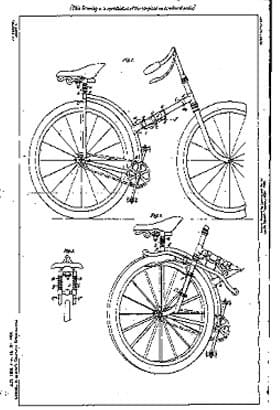


Another early folding bike (pictured below) incorrectly credited in some texts as the first folding bike was the Faun Folding Cycle, produced in England in 1896.
While it was not the first folding bike, its novelty was that it featured folding handlebars that integrated a brake mechanism. This innovation was invented by William Crowe, who was issued a patent on March 18, 1899.

France wasn’t the only country to recognize the potential of military use of folding bikes.
A New York Times article dated February 7, 1897, reported on military folding bicycles being displayed by the Dwyer Folding Bicycle Company of Danbury, Connecticut, at the Third National Cycle Exhibition held at the Grand Central Palace of Industry in New York City.
A clipping from the paper is shown below.
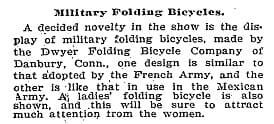
Photos from The Dwyer Folding Bicycle Company’s sales brochure are below. The first is the military folding bicycle (though it was also sold to the public), and the second is the ladies’ version of the bike mentioned in the article above.
The ladies version is virtually identical to the Faun folding bicycle discussed earlier.
The third photo is from an article about the Dwyer folding bicycle in the Scientific American magazine dated March 13, 1897, showing a soldier demonstrating the folding operation of the bike.


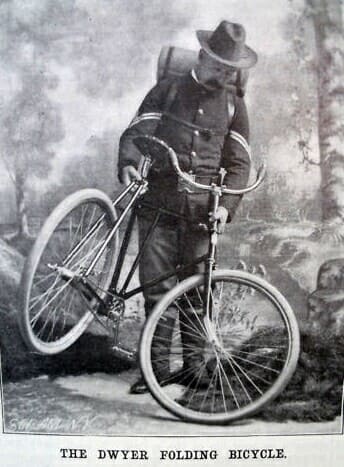
The Dwyer folding bicycle was most likely designed by Michael B. Ryan, mentioned earlier in this historical timeline. The evidence is that on October 13, 1896, he filed a patent for a folding bicycle that improved his earlier design.
The figures from the patent shown below bear a striking resemblance to the Dwyer bike. Also, a Dwyer sales brochure mentions that the Dwyer bikes are fitted with the “Ryan Adjustable Handlebars,” of which Michael B. Ryan was found to hold the patent.
Both Ryan and the Dwyer Folding Bicycle Company were based in Connecticut.
Ryan continued to make improvements and file folding bike patents, one of which may have been the basis for other military folding bikes that appeared in Europe since they are pretty similar in design.
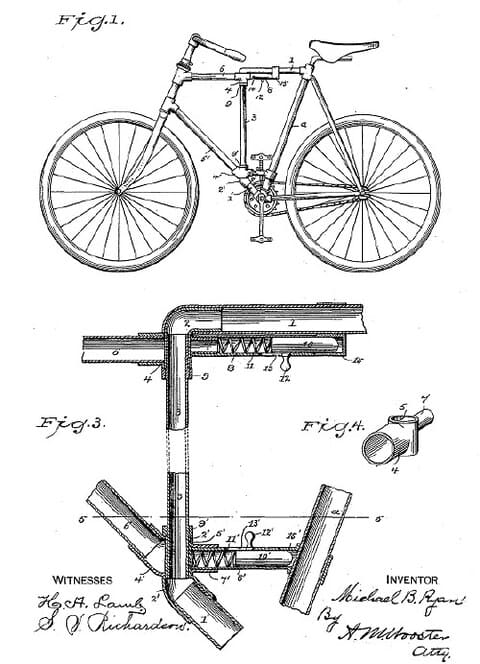
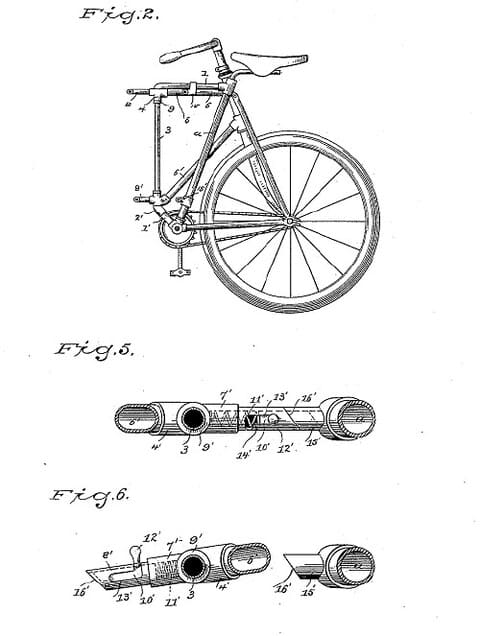
Many other countries made military use of folding bikes.
There were several manufacturers of them starting in the 1890’s such as Styria (Austria), Dursley-Pedersen (England), Faun (England), Seidel & Naumann (Germany), Fingers, Burgers (Holland), Peugeot (France), Bianchi (Italy), Leitner (Russia), Katakura (Japan) among others.
The English company BSA (Birmingham Small Arms) was the most widely known military folding bicycle manufacturer. They produced folding bikes by the thousands for use in WWI and WWII.
Below is an early example of a BSA military folding bike used by paratroopers.
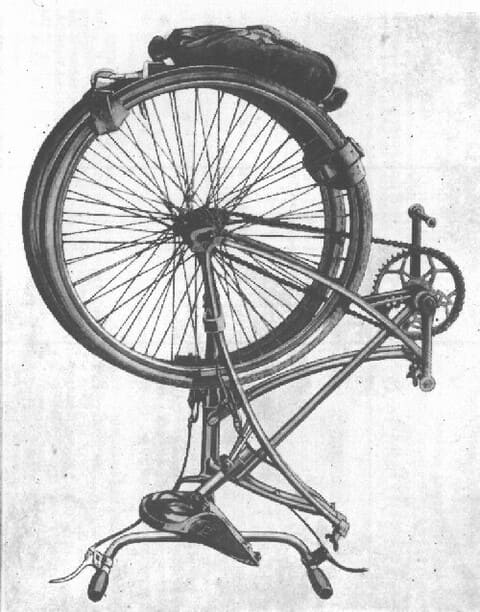
In the U.S., Columbia produced a bike around 1942 called the Compax for military use by paratroopers. This bike, seen below in the first image, was sometimes referred to as a folding bike. However, it didn’t fold; the frame was disassembled into two parts, as shown below in the civilian version of the bicycle (second photo).
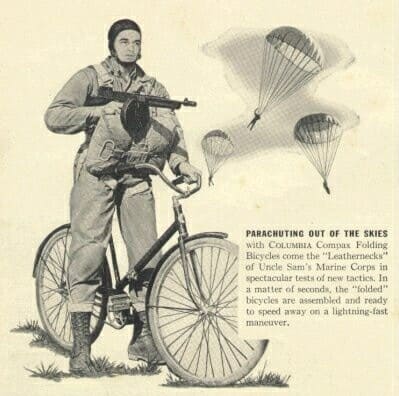
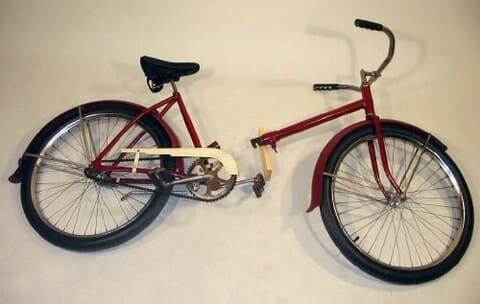
Towards the end of WWII, Raleigh in England also designed a military folding bike, but only a prototype was made, and it never went into production.
More recently, the U.S. military, who deployed the Montague Paratrooper in Iraq and Afghanistan, have used folding bikes.
Few folding bikes were produced during WWII for consumer use.
However, one bike worth mentioning is the Le Petit Bi from France, shown in a magazine advertisement below. Some texts, primarily in France, erroneously claim that this was the world’s first small-wheeled folding bike.
The frame didn’t fold.
Only the handlebars folded down as they do on the Japanese Katakura Porta-Cycle, and the frame separated. This corresponds to what it says in the ad in French, Démontable, or “can be taken apart, dismantled” in English and Pliable, or “foldable” in English.
The exact date and length of manufacture are unknown, but this bike was based on a design patented in 1939, and a few variations of the bike are known to exist.
This bike’s significance was that it was an early small-wheeled bike that may have inspired other designs, perhaps in England, since a few were imported. Further reading about the fascinating history of this bike can be continued here.

What may genuinely have been the first small-wheeled folding bike was developed in the early 1920s by an enigmatic inventor. Its story deserves its page, so follow the link to learn about the C.H. Clark folding bike, then return to continue reading.
The 1930s, ’40s, and ’50s were a seemingly quiet period in folding bike history.
During these decades, cycling started to decline worldwide due to the popularity of the automobile and, to some extent, motorcycles, plus the depression, WWII, etc. If anyone has any information regarding folding bikes from these decades, please get in touch with us since there are scant examples.
The 1960s saw the rekindling of interest in folding bikes.
Much of the impetus for this interest has been credited to the introduction of the Moulton bicycle in 1962. While not a folding bike per se, the Moulton (pictured below), with its small wheels, inspired many folding bicycle designs.
An even more significant influence on future folding bikes came with the Italian Graziella introduction in 1964, the design of which was widely copied even to this day. Noted Italian designer Rinaldo Donzelli designed its simple U-shaped frame.
The significance of this frame shape became evident in the 1970s.
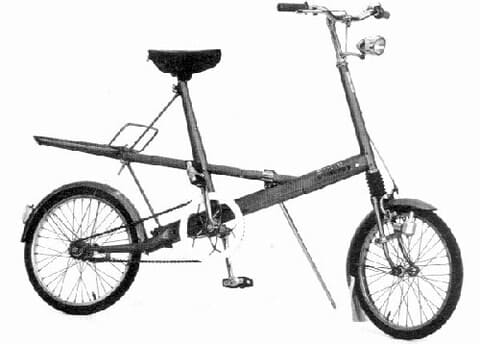
When Did Folding Bikes Become Popular?
By the 1970s, interest in folding bikes had picked up steam, with dozens of manufacturers in many countries producing folding bikes. The best-known and trendy folding bike from this decade was the Raleigh Twenty, made in England and New Zealand.
Initially introduced as the Stowaway model in 1971, it was produced until 1984.
This bike was notable since it was made in relatively large numbers and helped popularize internal hub gearing, specifically the Sturmey-Archer 3-speed hub. A catalog photo of a 1974 Raleigh Twenty Folder is shown below.
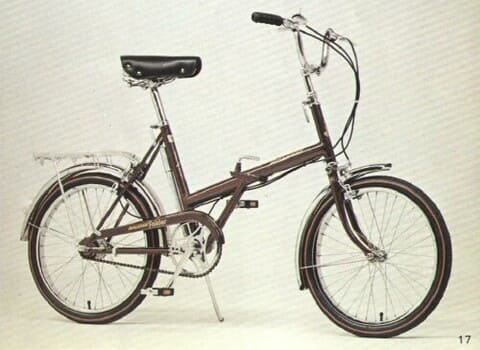
Another English folding bike of note was the Bickerton Portable, designed by inventor Harry Bickerton.
The bike had a lightweight aluminum frame and folded fairly compactly so it could be transported relatively easily, attributes not typically found in previous folding bikes.
This bike was significant because it was an innovative design (though of somewhat questionable function). It also served as one of the inspirations for Andrew Ritchie in creating his Brompton folding bike some years later since he was known to have seen the bicycle and thought he could do better.
The Bickerton Portable was produced from 1971 until 1991, with approximately 150,000 sold. A brochure photo of the Bickerton with its included carrying bag is shown below.
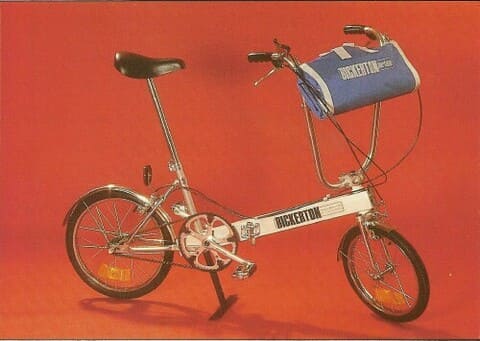
Vintage Folding Bicycle Brands
The 1970s saw a proliferation of folding bike models coming from:
- France (Astra, Peugeot, Motobécane, Motoconfort)
- Italy (Bianchi, Carnielli, Cinzia, Formicone, Rizzato)
- Austria (Dusika, Puch)
- West Germany (Heidemann Werke, Hercules, Jobafa, Kalkhoff, Kettler, Kynast, Panther, Rixe, Schauff, Staiger)
- East Germany (MIFA)
- Netherlands (Batavus, Gazelle)
- Poland (Romet, ZZR)
- Japan (Bridgestone)
- Spain (Beistegui Hermanos, G.A.C., Torrot)
- Argentina (Aurora, Bergamasco)
- Brazil (Caloi, Monark)
- United Kingdom (Raleigh, Dawes, Elswick Hopper)
- USA (Schwinn)
- USSR (Салют – “Salute” in Russian)
- Yugoslavia (Rog), etc.
Most bicycle companies had a folding bike offering during this decade, leading some to call it the “Golden Age of folding bikes .”
There was also a flood of cheap Eastern European so-called “U-frame” folding bikes (so named because the frame was shaped like the letter U) during the ’70s, many sold via mail order or at department stores and service stations.
Most of them carried phony brand names that gave little indication of their true origin of manufacture. Many of these U-frame folders were based on the Puch Pic-Nic folding bike design shown below.
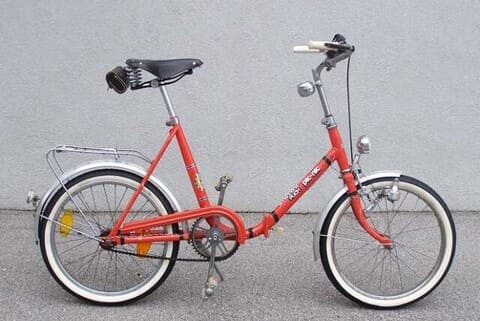
Johan Puch pioneered the single-tube U-frame (non-folding) in the late 1800s while working at the Syria Bicycle Company in Austria.
The Puch Pic-Nic was significant not only because its design was widely copied (Graziella, etc.) but also because its flaws were what inspired Harry Bickerton, among others, to design what they considered better folding bikes.
The 1980s began with two very significant events in folding bike history.
First, Andrew Ritchie began producing his Brompton folding bike in 1981. Then in 1982, Dr. David Hon, a physicist, began production of the first Dahon folding bike.
Brompton and Dahon are among the most popular folding bike brands.
Dahon has become the world’s largest folding bike manufacturer, with a comprehensive product range and an estimated 60% market share. The photo below shows Dr. Hon’s first folding bike, named “Da Bike .”

The second photo is the Dahon Mu XXV Limited Edition folding bike produced to celebrate the 25th anniversary of the company.
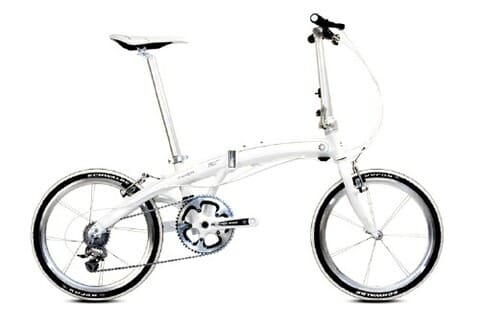
In 1987 Montague Bikes was founded by Harry and David Montague, father and son, to produce full-size folding bikes that have become quite popular.
The popularity of folding bikes has been relatively slowly developing over the years.
Still, it has accelerated recently because of its utility as a constituent part of multi-modal transportation, especially in Europe, Asia, and the larger cities in the United States. Today, over 175 folding bike manufacturers produce many models, and their number continues to grow.
Electric folding bikes are increasing in popularity, and many traditional folding bike manufacturers are starting to offer electric models, particularly in Asia and Europe.
In conclusion, this historical account of the folding bike has been relatively brief and was meant to be only partially comprehensive. However, more will be added over time as new facts are discovered.
This research project is in progress, and comments, additions, or corrections are welcome and appreciated.
Any help from professional historians and authors would be gladly accepted, as would contributions by visitors to the site who may know some interesting historical facts or have rare photographs.

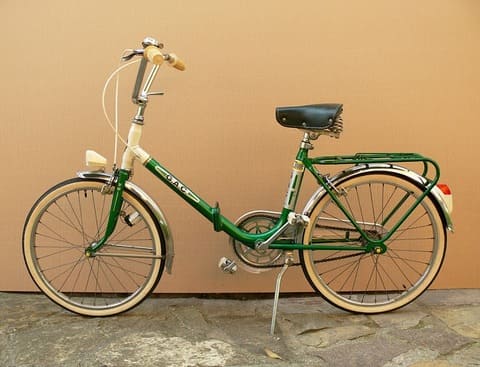
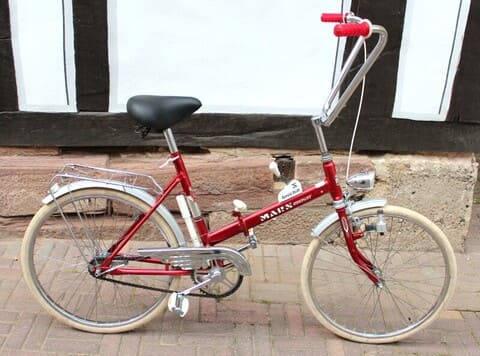
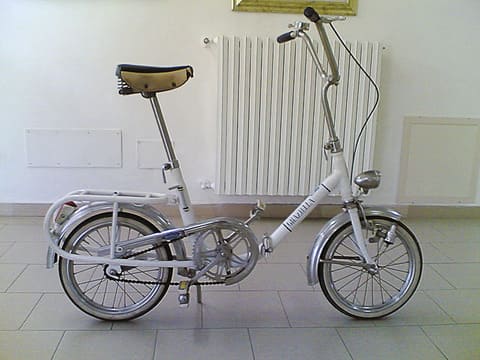
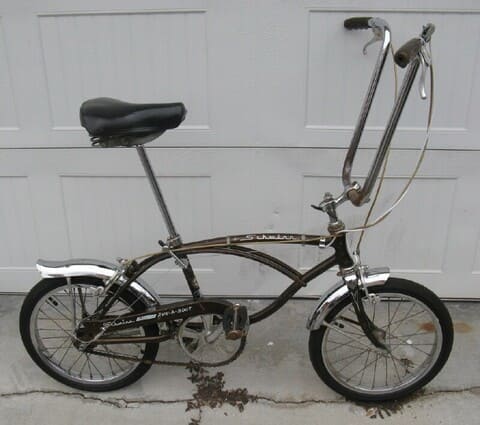
![Auto Mini Folding Bike Review [Year]](https://www.foldingbikeguy.com/wp-content/uploads/Auto-Mini-Folding-Bicycle.jpg)
